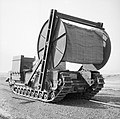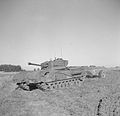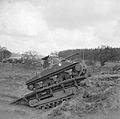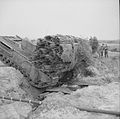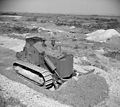Hobart's Funnies

Hobart's Funnies were a number of unusually modified tanks operated during World War II by the United Kingdom's 79th Armoured Division or by specialists from the Royal Engineers. They were designed in light of problems that more standard tanks experienced during the Dieppe Raid, so that the new models would be able to overcome the problems of the planned Invasion of Normandy. These tanks played a major part on the Commonwealth beaches during the landings. They may be considered the forerunners of the modern Combat engineering vehicle. They were named after their commander, Major General Percy Hobart.
History
The beginnings of the Funnies started with the need to create a series of modern siege engines to lead the assault on the beach defences of the French coast. A rapid sweeping away of the obstacles and defenders in the British sectors would be important as the lay of the land would favour a rapid counterattack by German armour. Field Marshal Sir Alan Brooke made the decision in 1943 to create these new units. Responsibility for the build up of vehicles and the training of crews to use them was given to armoured warfare expert Percy Hobart after whom the collection was named.
Many of the ideas had already been tried, tested or were in experimental development both by Britain and other nations. For example, the Scorpion flail tank (a modified Matilda tank) had already been used during the North African campaign to clear paths through German minefields. Soviet T-34 tanks had been modified with mine-rollers. Close-support tanks, bridgelayers, and fascine carriers had been developed elsewhere also. However, the Funnies were the largest and most elaborate collection of engineering vehicles available.
By early 1944, Hobart could demonstrate to Eisenhower and Montgomery a brigade each of swimming DD tanks, Crab mine clearers, and AVRE (Engineer) tanks along with a regiment of Crocodile flamethrowing tanks.
Montgomery considered that the US forces should use them, and offered them a half-share of all the vehicles available, but take-up was minimal. Eisenhower was in favour of the amphibious tanks but left the decision on the others to General Bradley who delegated it to his staff officers. None of the other designs were used, because it was thought that they required specialised training and an additional support organisation.[1]
Designs
The majority of the designs were modified forms of the Churchill tank or the Sherman tank. Both were available in large numbers. The Churchill had good (though slow) cross-country performance, heavy armour, and a roomy interior. The Sherman's mechanical reliability was valued.
Among the many specialist vehicles and their attachments were:
- Crocodile - A Churchill tank modified by the fitting of a flame-thrower in place of the hull machine gun. An armoured trailer, towed behind the tank, carried 400 Imperial gallons (1,800 litres) of fuel. The flamethrower had a range of over 120 yards (110 m). It excelled at clearing bunkers and it was a strong psychological weapon (see Flame tank).
- AVRE - Armoured Vehicle, Royal Engineers was a Churchill tank adapted to attack German defensive fortifications. The crew of six were drawn from the Royal Engineers, except for the driver who came from the Royal Armoured Corps. One of the RE crew was a demolitions NCO sapper responsible for priming the "Flying dustbin" as well as leading or supervising when they dismounted from the tank (easily done through the side hatches) to place demolition charges ("Wade" charges). The AVRE had the main gun replaced by a Petard Mortar. This fired a forty pound (18 kg) HE-filled projectile (nicknamed the Flying Dustbin) 150 yards (137 m). The "Dustbin" could destroy concrete obstacles such as roadblocks and bunkers. This weapon was unusual in that it had to be reloaded externally - by opening a hatch and sliding a round into the mortar tube from the hull. AVREs were also used to carry and operate equipment such as:
- Bobbin - A reel of 10-foot (3.0 m) wide canvas cloth reinforced with steel poles carried in front of the tank and unrolled onto the ground to form a "path", so that following vehicles (and the deploying vehicle itself) would not sink into the soft ground of the beaches during the amphibious landing.
- Fascine - A bundle of wooden poles or rough brushwood lashed together with wires carried in front of the tank that could be released to fill a ditch or form a step. Metal pipes in the center of the fascine allowed water to flow through.
- Small Box Girder was an assault bridge that was carried in front of the tank and could be dropped to span a 30-foot (9.1 m) gap in 30 seconds.
- Bullshorn Plough. A mine plough intended to excavate the ground in front of the tank, to expose and make harmless any land mines.
- Double Onion two large demolition charges on a metal frame that could be placed against a concrete wall and then detonated from a safe distance. It was the successor to the single charge device Carrot.
- ARK - Armoured Ramp Carrier was a Churchill tank without a turret that had extendable ramps at each end; other vehicles could drive up ramps and over the vehicle to scale obstacles.
- Crab - A modified Sherman tank equipped with a mine flail, a rotating cylinder of weighted chains that exploded mines in the path of the tank.
- DD tank - from "Duplex Drive", an amphibious Sherman or Valentine tank able to swim ashore after being launched from a landing craft several miles from the beach. They were intended to give support to the first waves of infantry that attacked the beaches. The Valentine version was used only for training.
- BARV - Beach Armoured Recovery Vehicle. A Sherman M4A2 tank which had been waterproofed and had the turret replaced by a tall armoured superstructure. Able to operate in 9 foot (2.7 m) deep water, the BARV was intended to remove vehicles that had become broken-down or swamped in the surf and were blocking access to the beaches. They were also used to re-float small landing craft that had become stuck on the beach. Strictly speaking, Sherman BARV's were not "Funnies" as they were developed and operated by the Royal Electrical and Mechanical Engineers, not the 79th Armoured Division.
- LVT "Buffalo" - British version of the American LVT4: an armoured amphibious landing vehicle.
- Armoured Bulldozer - A conventional Caterpillar D7 bulldozer fitted with armour to protect the driver and the engine. Their job was to clear the invasion beaches of obstacles and to make roads accessible by clearing rubble and filling in bomb craters. Conversions were carried out by a Caterpillar importer Jack Olding & Company Ltd of Hatfield.
- Centaur Bulldozer, a Cromwell tank with the turret removed and fitted with a simple, winch operated, bulldozer blade. These were produced because of a need for a well-armoured, obstacle clearing vehicle that, unlike a conventional bulldozer, would also be fast enough to keep up with tank formations. They were not used on D-Day but were issued to the 79th Armoured Division in Belgium during the latter part of 1944.
- Canal Defence Light This was a powerful carbon-arc searchlight carried on several types of tank inside a modified turret. The name of the device was deliberately inaccurate in order to help keep it secret - its true purpose was to blind the defenders during a night attack and so help obscure attacking forces. An ingenious optical design allowed the light to flood out of a comparatively small slit in the armour, minimising the chance of damage by enemy fire. This was not used on D-Day, but was used during the attack on the Geilenkirchen salient to create indirect artificial daylight.
-
Churchill AVRE with a bobbin
-
Close-up of an AVRE's Petard Mortar
-
Churchill Crocodile
-
A Sherman tank uses a Churchill Ark to climb an escarpment during a training exercise
-
A Churchill AVRE, carrying a fascine, crosses a ditch using an already deployed fascine, (1943)
-
Centaur Bulldozer
-
A D7 armoured bulldozer
Many of the prototypes and their auxiliary equipment were developed by AEC. [2]
Post-WWII use
The Centaur bulldozer continued to be used by the British Army for some years after World War II and saw action during the Korean War. Also, small numbers of Churchill AVREs and Sherman BARVs were used until the 1960s when they were replaced with similar vehicles based on the Centurion Tank. The Royal Engineers subsequently used modified Centurion and Chieftain tanks that are designed to fulfill the same roles in battle as the Funnies. The last examples of FV4003 Centurion Mk 5 AVRE 165 saw combat in the Gulf War / Operation Granby of 1991. The most recent vehicles in this line are the Titan and Trojan variants of the Challenger 2 tank.
Armoured bulldozers continue to be used by the Israel Defense Forces and have been recently adopted by the US Marine Corps and the US Army in Iraq.
Surviving vehicles

This is an incomplete list:
- Churchill ARK - A Churchill ARK is in South Africa, owned by the School of Engineering, Kroonstad.
- Churchill AVRE - The collection of the Bovington Tank Museum includes a working Mark III Churchill AVRE. Another example is located in a hamlet of Graye-sur-Mer in Normandy; it is unusual in having been buried on D-Day in the shell-hole it fell into, and then being recovered later as a memorial. MkIV AVREs are at the Imperial War Museum Duxford, the South African Armour Museum and the National Museum of Military History, Johannesburg. A MkVII AVRE is a Gate guardian at the Allenby Barracks, at the Bovington army camp, headquarters of the Royal Wessex Yeomanry; another is at the Royal Engineers museum at Chatham, Medway. Several more AVREs still exist as wrecks on gunnery ranges.
- Churchill Crocodile - There is one example, without trailer, on display at the Bayeux Museum of the Battle of Normandy. A trailer is held at Bovington. Mark VII Crocodiles are owned by the Muckleburgh Collection in Norfolk, the Cobbaton Combat Collection in Devon, the D-Day museum, the Wheatcroft Collection, the Kubinka Tank Museum in Russia and the Museum of the Regiments, Calgary, Alberta. A Mark VIII is at the Royal Australian Armoured Corps Museum. Two (one in running order) are privately owned in the UK. One example at Fort Montbarey near Brest France where they were used in September 1944.
- Sherman DD - Five Sherman DDs are in museums; one is nearly intact, four were sunken wrecks that were salvaged. See the main article for details.
- Sherman Crab - Sherman Crabs are displayed at the CFB Borden Military Museum, Ontario, Canada; the Bovington Tank Museum, the Yad La-Shiryon museum in Israel and the Overloon War Museum in the Netherlands.
- Centaur Dozer - One is part of the collection at Bovington. Another is part of a private collection in the UK.
- BARV - Three BARVS are held by museums in England and one by a museum in India. One, in running condition, is privately owned in the UK.
- Canal Defence Light - The Bovington Tank Museum has a Matilda tank fitted with a Canal Defence Light turret. This is the only survivor of this type of vehicle.
- Buffalo aka Amtrac LVT4 - The Bovington Tank Museum has an example.
References
- ^ "Omar Nelson Bradley". Arlington National Cemetery. 26 March 2006. Retrieved 8 Jun 2009.
{{cite web}}: Cite has empty unknown parameter:|coauthors=(help) - ^ Contribution to victory. Pages 32, 67 The Associated Equipment Co. Ltd. Accessed 2010-08-11
See also
Further reading
- Delaforce, Patrick. Churchill's Secret Weapons: The Story of Hobart's Funnies. (2007) ISBN 9781844154647
External links
- Bradley's biography with explanation of refusal of "funnies"
- Royal Engineers Museum Royal Engineers and Operation Overlord
- Royal Engineers Museum Biography of Major General Sir Percy Hobart
- Royal Engineers Museum Royal Engineers and Second World War

